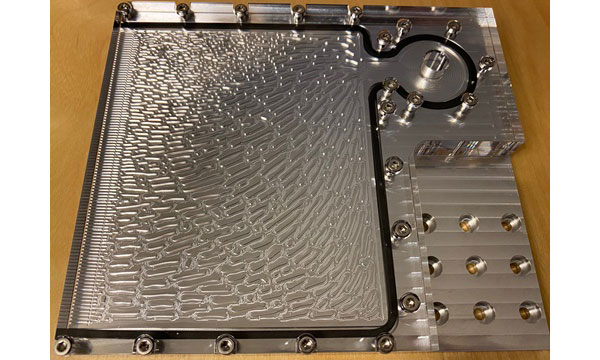TRINA Picks COMSOL Multiphysics
The Toyota research team engineered a novel approach by integrating the COMSOL Multiphysics software into its inverse design workflow, institute reports.

A metal flow field plate prototype based on one of the TRINA team’s generated designs. Image courtesy of COMSOL/TRINA.
Latest News
May 26, 2023
Toyota Research Institute of North America (TRINA) has developed a new simulation-driven inverse design methodology to accelerate the research and development process for fuel cell flow field plates, according to TRINA. The methodology sets performance objectives and directs algorithms to generate structural flow field forms that fulfill those objectives. The TRINA team engineered this approach by integrating the COMSOL Multiphysics software into its inverse design workflow.
“We think that the inverse design approach can revolutionize current design practice,” says Yuqing Zhou, a research scientist at TRINA. “We are enabling the next step in a long journey, even though we cannot know exactly where that journey will lead.” The team at TRINA applied its method to the design of flow field microchannel plates, which direct the movement of fluid reactants in microreactors like hydrogen–oxygen fuel cells.
TRINA is part of a large network of Toyota R&D teams that are working toward the development of a “hydrogen society,” where fossil fuel-burning engines, heating systems and generators would be replaced by fuel cells that extract electric current from hydrogen.
“Fuel cell technology has the potential to provide clean energy globally,” says Margaret Lemus, vice president of marketing at COMSOL. “To achieve this, the technology needs to become more efficient, and optimizing the designs is an important step. It’s exciting to see how simulation empowers researchers to explore different options and make informed decisions that can lead to more efficient fuel cell designs.”
Optimizing Designs for Flow, Reaction or Both
During their research, Zhou and his colleagues recognized that they needed to optimize their design process before they could optimize their designs. “We were seeking an efficient way of approximating what a more complex simulation would show. We have sacrificed some modeling complexity, which actually enables us to explore more elaborate designs in less time,” says Zhou.
When their design was optimized for fluid flow, the generated microchannel paths were straight and parallel, with little side branching. When the weighting factors in the objective function were adjusted to prioritize reaction uniformity, the method generated intricate microchannel forms.
In a research paper, published in Chemical Engineering Journal, the TRINA team also notes that some have previously experimented with natural-looking, fractal, or hierarchical forms selected a priori for flow field channels. About TRINA’s own research, Zhou says, “This is the first time that such large-scale branching flow fields have been discovered using an inverse design approach without assuming prescribed layouts.”
Sources: Press materials received from the company and additional information gleaned from the company’s website.
More COMSOL Coverage
Subscribe to our FREE magazine, FREE email newsletters or both!
Latest News
About the Author
DE’s editors contribute news and new product announcements to Digital Engineering.
Press releases may be sent to them via [email protected].






